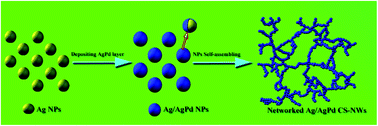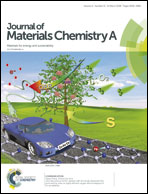Bifunctional networked Ag/AgPd core/shell nanowires for the highly efficient dehydrogenation of formic acid and subsequent reduction of nitrate and nitrite in water†
Abstract
Nitrate (NO3−) and nitrite (NO2−) pollution in water has increasingly become a serious environmental concern. The catalytic reduction of NO3− and NO2− to harmless N2 by a reducing agent is considered to be one of the most promising methods to remove NO3− and NO2− from water. Herein, we report the one-pot synthesis of networked Ag/AgPd core/shell nanowires (CS-NWs) via seed-mediated growth in polyol solution. The shell thickness of the networked Ag/AgPd CS-NWs can be readily controlled by tuning the amount of precursors. The networked Ag/AgPd CS-NWs with a 0.9 nm shell thickness exhibited the highest activity towards the dehydrogenation catalysis of FA with an initial TOF of 1400 h−1 at 50 °C, and the highest selectivity for the catalysis of NO3− and NO2− to N2 in water and at room temperature. Their enhanced bifunctional catalytic performance could be attributed to more efficient electron transfer from PVPI and Ag to Pd. This work demonstrates a new way to prepare bifunctional nanocatalysts for the removal of NO3− and NO2− from water using FA as the in situ hydrogen source.



 Please wait while we load your content...
Please wait while we load your content...